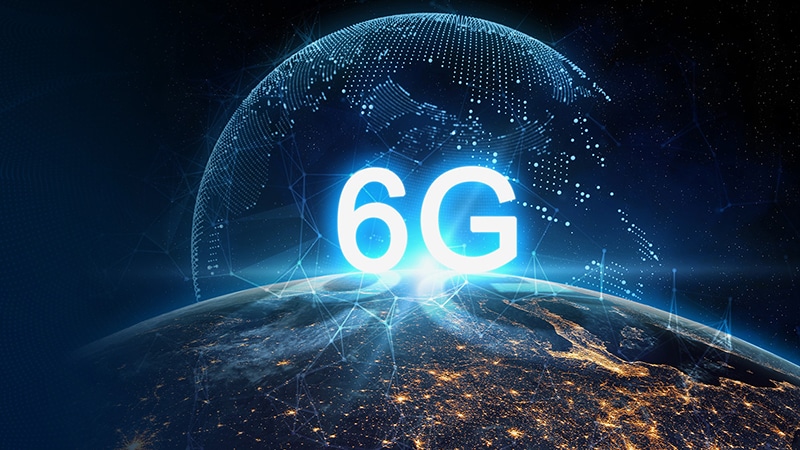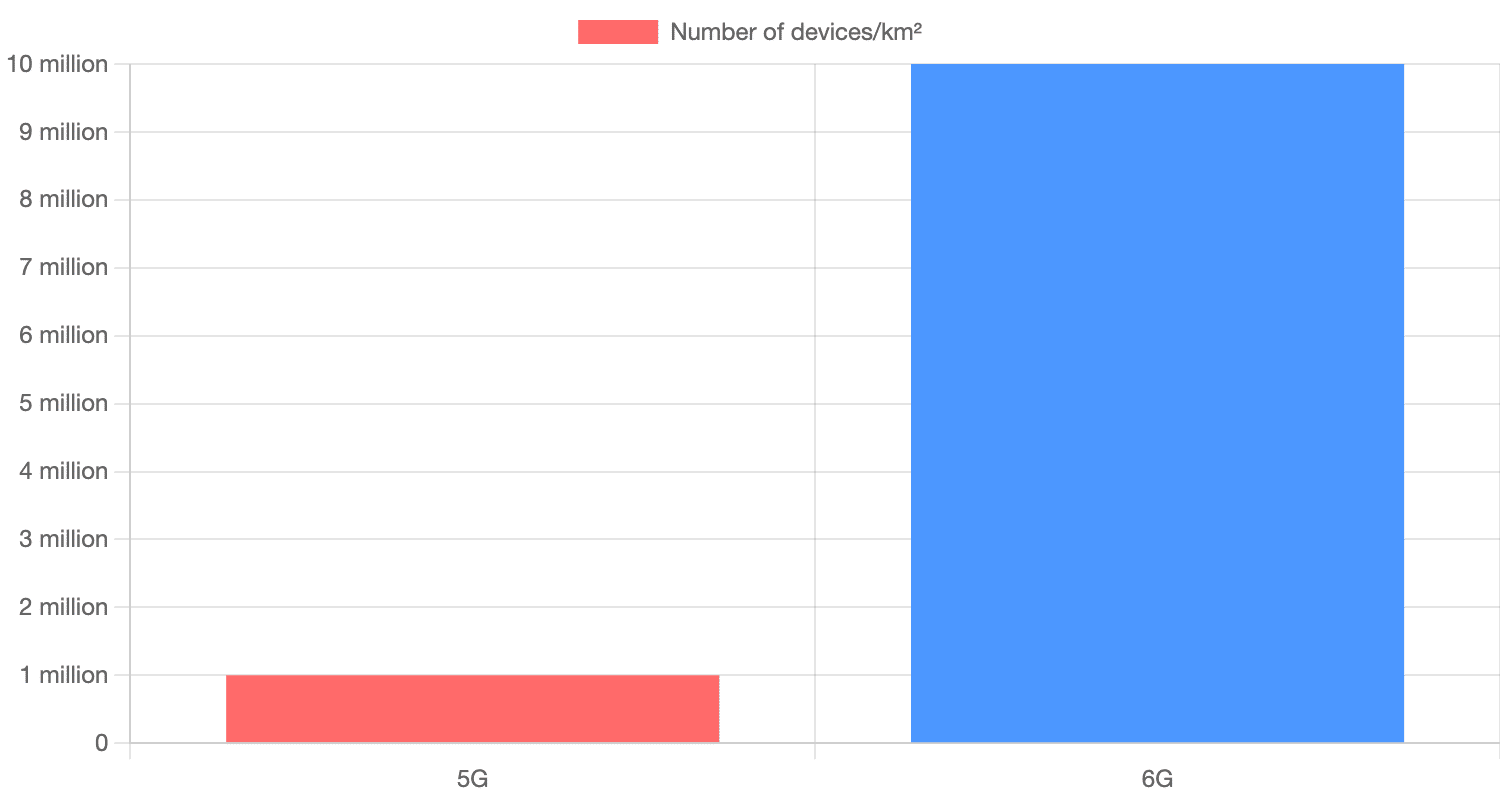Radio Waves and 6G: Paving the Future of Communication & The Crucial Role of RF Microwave Calibration

In the relentless march of technological innovation, the world is preparing to enter a new chapter: 6G. Going far beyond the achievements of 5G. 6G promises an era of instant, intelligent, and ubiquitous connectivity where the physical and virtual worlds merge seamlessly. The foundation for this revolution is none other than radio waves. But to fully unlock their potential at unprecedented frequencies. The role of RF (Radio-Frequency) Microwave calibration is more vital than ever. This article will deeply analyze the application of radio waves in 6G technology and emphasize the core importance of precise calibration.
The 6G Era: Surpassing the Limits of 5G
Comparison Table of Key Technical Features
Device Density: 5G vs. 6G
The bars below illustrate the incredible increase in device connectivity, showing that 6G will be the foundation for a hyper-connected world with billions of IoT devices.

The 5G network laid the groundwork for a faster, connected society with gigabit speeds and low latency, fostering the development of autonomous vehicles, virtual reality (VR), and the Internet of Things (IoT). However, the ambitions of the future demand far more. 6G is projected to deliver incredible leaps:
- Terabit-level Data Speeds (Tbps): 10 to 100 times faster than 5G, allowing a high-definition movie to be downloaded in just milliseconds.
- Sub-1 Millisecond Latency: Almost zero latency, paving the way for applications requiring instantaneous feedback like remote surgery, holographic communication, and the “Tactile Internet.”
- Ultra-High Reliability and Connection Density: Supporting millions of devices per square kilometer, forming the basis for smart cities, fully automated factories, and global AI systems.
To achieve these extraordinary goals, scientists and engineers must explore new territories in the electromagnetic spectrum, where radio waves operate under entirely different principles.
Radio Waves – The Solid Foundation for 6G Networks
Radio waves are the medium for wireless data transmission. To increase speed and capacity, the only way is to broaden the “road” on which data travels—meaning using a wider bandwidth. This forces 6G to move into ultra-high frequency ranges.
Exploring New Frequencies: The Terahertz (THz) Era
The heart of 6G is the utilization of the Sub-Terahertz and Terahertz (100 GHz to 10 THz) frequency bands, an area largely untapped for commercial communication. Radio waves in this range have unique properties:
- Immense Bandwidth: Provides a “superhighway” for data, enabling transmission speeds to reach Terabits per second.
- Extremely Short Wavelengths: Allows for the creation of tiny antennas, enabling the integration of thousands of them into a single device, which facilitates advanced transmission technologies.
- Environmental Sensitivity: THz waves are easily absorbed by air, water vapor, and physical obstructions. This is both a challenge for coverage and an advantage for security, as the signal is difficult to intercept from a distance.
Successfully harnessing the THz spectrum is the key to realizing the vision of 6G’s speed and capacity.
Advanced Antenna Technology and Intelligent Communication
To overcome the range limitations of THz waves and optimize performance, 6G will heavily rely on technologies like Massive MIMO (Multiple-Input Multiple-Output) and Beamforming. These intelligent antenna systems will focus radio wave energy into extremely narrow beams, directing them straight to the user’s device instead of broadcasting widely. This technology not only helps the signal travel farther and stronger but also minimizes interference and increases energy efficiency.
However, operating at THz frequencies with nanosecond-level precision requires a fundamental element: every component in the system must be measured and adjusted with absolute accuracy. This is where RF Microwave calibration plays an irreplaceable role.
RF Microwave Calibration: The Key to Ensuring 6G Performance and Reliability
RF Microwave calibration is the process of comparing a device’s measurement parameters (e.g., power, frequency, noise) against a known standard to ensure its accuracy. In the context of 6G, where frequencies increase by hundreds of times and wavelengths shrink to sub-millimeter levels, the smallest discrepancies can lead to catastrophic consequences, from data loss to a complete connection failure.
Imagine steering a laser beam toward a target hundreds of meters away. A deviation of just 0.01 degrees at the source can cause the beam to miss the target by several meters. The same principle applies to THz waves in 6G. Without proper calibration, the signal beams will fail to reach the device accurately, causing dropped connections.
The Role of Calibration at Every Stage
Calibration is a crucial factor throughout the entire lifecycle of 6G technology:
- Research and Development (R&D): Scientists need accurately calibrated measurement instruments to design and test new semiconductor components, antennas, and transceivers. Without reliable measurement data, they cannot verify theoretical simulations or improve the technology.
- Manufacturing: Every chip and antenna module produced must meet extremely strict technical specifications. Calibration on the production line ensures consistent quality and compatibility between components from different suppliers.
- Deployment and Operation: When 6G base stations are installed, they must be calibrated to operate harmoniously and avoid mutual interference. Periodic calibration is also essential to maintain network performance, compensating for equipment aging and environmental changes.
The Challenges of Terahertz Frequency Calibration
Calibrating at THz frequencies presents immense technical challenges. The signals are weaker and more prone to attenuation, and the smaller physical components make connections and measurements incredibly complex. This requires new standards, more sophisticated measurement equipment, and highly specialized engineering teams. Calibration labs must invest in advanced technology to provide reliable measurement services to the telecommunications industry.
The Future of 6G and the Ever-Increasing Importance of Calibration
As we move closer to the 6G era, the race is not just about inventing new technology but also about mastering it. Radio waves in the Terahertz range offer boundless potential, but to turn that potential into reality, we need a solid foundation of measurement and accuracy.
RF Microwave calibration is no longer a simple technical support step. It is a core factor that will determine the success or failure of 6G networks. Any compromise on calibration accuracy will lead to a decline in the performance and reliability of the entire system.
Conclusion 6G technology promises to reshape how we live, work, and interact. This journey to the future is built upon the invisible foundation of radio waves. And to ensure that foundation is solid, nothing is more critical than the strict discipline and absolute precision of RF Microwave calibration. Investing in calibration technology is an investment in a future of smart, stable, and reliable connectivity.
The Role of AI in 6G
While AI supports 5G networks, it will become an autonomous, core part of 6G. Here is how AI will shape the network of the future:
- Autonomous network management: AI will optimize performance, detect, and fix errors without human intervention.
- Intelligent communication: Devices will learn and predict user needs, self-adjusting to save energy and optimize bandwidth.
- Enhanced security: AI will proactively identify and block threats in real-time.
- Dynamic resource allocation: AI will flexibly allocate resources to meet diverse application demands instantly.
The Role of Frequency Bands in 6G
6G networks will utilize a wide spectrum, from low to ultra-high bands, to build a comprehensive connectivity ecosystem.
Role: Wide coverage, good obstacle penetration.
Application: Wide area IoT, rural communication.
Role: Balancing speed & coverage.
Applications: Mobile communications, video services.
Role: Ultra-fast speed, high bandwidth.
Applications: VR/AR, 3D communication, ultra-low latency.
Relative Contribution of Frequency Bands

Low Range (15%)
Mid Band (35%)
High Band & THz (50%)



